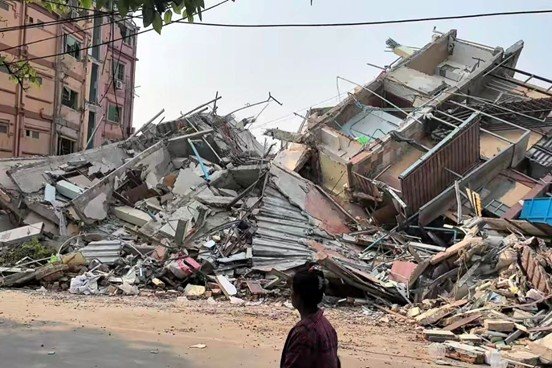On March 28th, at noon, a powerful 7.7 magnitude earthquake struck Myanmar, followed by a 6.4 magnitude aftershock 12 minutes later. The second-largest city near the epicenter, Mandalay, was severely affected. Witnesses revealed that many people were buried under a collapsed hotel, emitting a foul stench of death in the air. The damage to transportation infrastructure has heightened the difficulty of rescue efforts.
The epicenter of the earthquake was located 16 kilometers northwest of Mandalay, with a depth of 10 kilometers, affecting a population of around 1.5 million.
Wang Hao from Ruili, Yunnan, who does jewelry business in Mandalay (known as “Wacity” by the local Chinese community), recounted his experience on March 30th, stating that he was residing in the Win Star Hotel when the earthquake struck. Wang described how a building adjacent to the hotel collapsed, trapping individuals inside, making rescue operations challenging.
The majority of guests staying at the Win Star Hotel were Chinese nationals, mainly engaged in jade and jewelry business. Wang mentioned that approximately 20 people were believed to be buried under the hotel. Despite rescue teams arriving, it was discovered that those trapped had no signs of life, prompting rescuers to prioritize other locations.
It was noted that on the day of the earthquake, which coincided with a local Buddhist festival, over two hundred monks were taking an examination inside a temple, where over a hundred of them were trapped following the temple’s collapse.
The initial earthquake did not cause many buildings to collapse, but subsequent aftershocks, including the 6.4 magnitude tremor, led to the collapse of numerous structures. The inadequacy of the support pillars in older buildings exacerbated the destruction, resulting in significant loss of life and property.
Zheng Lan, also engaged in the jade and jewelry business in Mandalay, expressed the devastation caused by the earthquake. She mentioned the difficulty in conducting rescue operations due to the increasing death toll, ongoing aftershocks, and the oppressive heat in the heavily impacted areas.
The earthquake survivor He Liang from Jiangxi, who narrowly escaped the disaster as he had left the Win Star Hotel prior to the collapse, emphasized the substandard construction practices prevalent in Mandalay. He highlighted the risks posed by unauthorized structural modifications that compromised building integrity, contributing to the widespread devastation.
The safety of individuals has become a paramount concern, with those able to leave seeking refuge in other locations. However, the collapse of the airport in Mandalay has disrupted transport, making travel to safer areas challenging. The region’s volatile political situation, dotted with landmines, further complicates rescue operations, requiring local communities to rely primarily on self-rescue efforts.
Reports indicate that the Sky Villa Apartments in Mandalay, known for its high security and amenities, suffered catastrophic structural collapse, with a significant number of casualties, including many Chinese nationals. Efforts to rescue survivors from the debris have been hampered by the extensive damage to roads and bridges, necessitating unconventional means such as boat transportation.
As per the latest statistics released by the Myanmar National Management Council’s news information group, casualties from the earthquake continue to rise, with 2,056 fatalities, 3,900 injuries, and 270 missing persons reported as of 12:00 on March 31st (local time). Efforts to assess the full extent of the devastation and provide aid to the affected population are ongoing amidst the challenging circumstances in the region.

